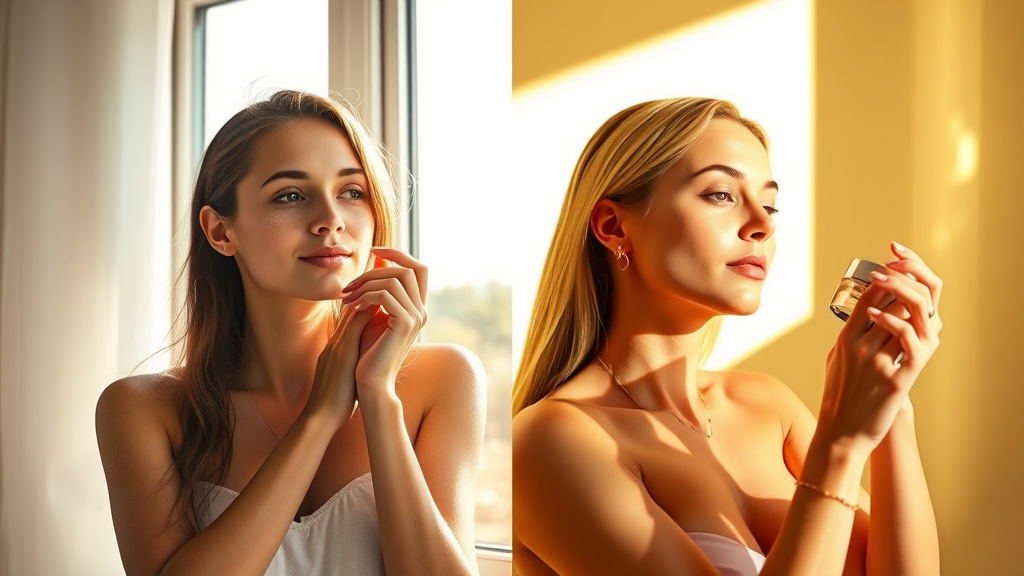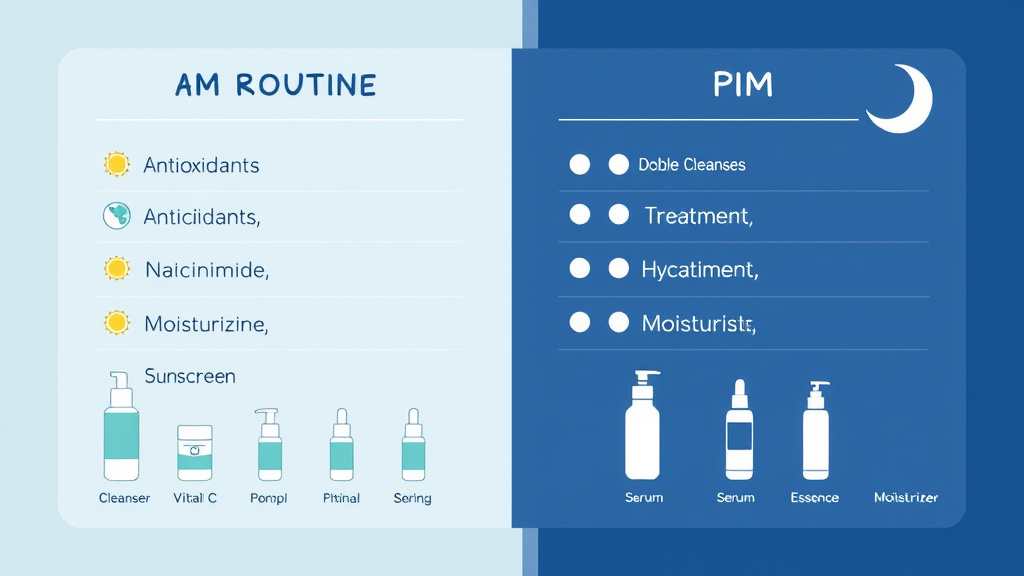When it comes to skincare, understanding the differences between your AM vs PM skincare routine can make a noticeable impact on your skin’s health and appearance. The morning skincare routine primarily focuses on protecting your skin throughout the day, while the evening skincare routine aims to repair, restore, and prepare your skin for the night. Recognizing the role each routine plays helps in building an effective day vs night skincare regimen that supports your skin barrier, enhances renewal, and optimizes ingredients like antioxidants and retinol. This detailed guide will break down the essential steps in both routines, highlight their core differences, and provide practical tips for achieving balanced, healthy skin.
Introduction: Why AM vs PM routines matter

Understanding why AM vs PM routines matter begins with appreciating your skin’s natural rhythm. During the day, your skin is exposed to environmental stressors like pollution and UV rays, which can cause oxidative stress and damage. At night, your skin shifts into repair mode, amplifying cell turnover and regeneration. Tailoring your skincare routine to these natural cycles maximizes the benefits of your products and supports your skin’s health over time.
The skincare routine order varies significantly between morning and evening. In the morning, you want to focus on creating a protective barrier that deflects damage from external sources, using ingredients like antioxidants and sunscreens. At night, your priority shifts to nighttime renewal, utilizing ingredients that can support skin repair, such as retinol or exfoliants like AHA/BHA. By understanding the main differences in your day vs night skincare, you can prevent overuse or misuse of potent ingredients, which might compromise your skin barrier or cause irritation.
A well-structured AM vs PM skincare routine feeds into the larger goal of maintaining balanced, resilient skin. Even if your routine is simple, assigning specific products to the right time supports your skin’s natural processes. For instance, applying a vitamin C serum in the morning boosts antioxidant protection, while using a retinol at night encourages cellular renewal. Proper skincare routine order—from cleansing to moisturizing—ensures the ingredients work synergistically rather than cancel each other out.
Following the correct skincare routine order ensures each product works effectively.
According to WebMD’s skincare routine guide, layering products properly can maximize absorption and minimize irritation.
What is an AM Skincare Routine? (Morning Benefits Steps)

Starting your day with a thoughtful morning skincare routine can help protect your skin from environmental stressors, hydrate, and prepare it for makeup or daily activities. The focus during the AM skincare routine is on defense—shielding your skin against UV rays, pollution, and free radicals. A typical morning regimen is designed to help your skin stay resilient, fresh, and healthy throughout the day.
Step 1: Cleanser
Your morning cleanser should be gentle yet effective at removing excess oil, sweat, and any leftover skincare from the night. For those with oily or acne-prone skin, a gel or foaming cleanser containing salicylic acid (BHA) [product suggestion] can help maintain your skin’s clarity without stripping moisture. Those with sensitive or dry skin may prefer a milder, hydrating cleanser that preserves the skin barrier.
Using a proper cleanser in the morning prepares your skin to better absorb subsequent products like antioxidants and moisturizers. It’s important not to over-cleanse, which can disturb the delicate skin barrier and cause dryness or irritation. Ideally, a double cleanse isn’t necessary in the morning unless you use heavy night products, but a good rinse with lukewarm water followed by a gentle cleanser is sufficient.
Step 2: Antioxidants (Vitamin C, Niacinamide)
In the day skincare, antioxidants are key. Vitamin C serums, in particular, support your skin by neutralizing free radicals from UV exposure and pollution. These compounds can support collagen production and brighten your complexion. Niacinamide, another powerful antioxidant, can help with pore size, redness, and overall skin tone, making it an excellent addition to your morning routine.
Applying antioxidants in the AM routine provides a protective shield throughout the day. They work best when used consistently and properly layered under sunscreen, if used in the same routine. Since vitamin C is unstable and sensitive to light, applying it early in your routine enhances its stability and effectiveness. Be sure to follow with a moisturizer to lock in hydration and prepare your skin for sunscreen.
Step 3: Moisturizer
A gel moisturizer is often suitable for oily skin, providing hydration without excess oiliness. For dry or sensitive skin, richer creams with ceramides can help reinforce the skin barrier and prevent dehydration. Moisturizers help to trap the benefits of antioxidant serums in the skin, keeping hydrating ingredients like hyaluronic acid [product suggestion] close and available throughout the day.
Your choice of moisturizer should align with your skin type and environmental needs. In the morning, a lightweight, non-comedogenic formulation reduces the risk of clogged pores while providing necessary hydration. Ingredients like niacinamide can also support the barrier, helping prevent moisture loss while calming skin from potential irritation.
Step 4: Sunscreen
No AM skincare routine is complete without broad-spectrum SPF 50 protection. A mineral or chemical sunscreen provides a physical barricade against UVA and UVB rays, preventing premature aging and damage. Reapplying your sunscreen during the day is vital—use a lightweight, re-application-friendly formula if you’ll be outdoors [Sunscreen 101].
Sunscreen should be applied last after moisturizer, ideally 15 minutes before sun exposure. Layering it over your antioxidant serum ensures your skin benefits from both protection and repair agents. If applying makeup, opt for a primer with added SPF for extra coverage.
What is a PM Skincare Routine? (Nighttime Benefits Steps)
Your evening skincare routine is where your skin can unwind, repair, and prepare for the next day. During nighttime, your skin’s repair processes are active, making it the ideal time to incorporate treatments like retinol and exfoliants that promote cellular renewal and address specific concerns. The focus ultimately turns inward—supporting the skin barrier while calming any skin sensitivities that may have been aggravated during the day.
Step 1: Double Cleanse
A double cleanse is the cornerstone of a nighttime routine, especially if you wear makeup, sunscreen, or heavy skincare during the day. The first cleanse involves an oil-based or balm option to dissolve makeup, sebum, and SPF. Followed by a water-based cleanser to remove residual dirt and impurities. This ensures a clean canvas and optimizes absorption of active ingredients in subsequent steps.
Double cleansing respects your skin barrier by avoiding harsh scrubbing or over-cleansing. It also prevents clogged pores and breakouts caused by buildup from outdoor exposure. Use gentle, non-comedogenic cleansers suitable for your skin type, and avoid overly foaming formulas that might strip essential lipids.
Step 2: Treatment (Retinol, AHA/BHA)
This step is where the power of nighttime renewal shines. Retinol, a derivative of Vitamin A, can support cell turnover and improve skin texture, fine lines, and pigmentation [Niacinamide Guide] to work well with retinol. Start with a low concentration (around 0.25–0.5%) and gradually increase, as retinol may cause irritation if used improperly.
Exfoliants like AHA or BHA can break down dead skin cells and clear pores. BHA (salicylic acid) is particularly effective for oily or acne-prone skin, while AHA (glycolic, lactic) suits dry or dull skin types. Use these exfoliants 2-3 times a week, avoiding overuse, which can compromise your skin barrier.
Step 3: Hydration (Serum, Essence)
Hydrating products help soothe and repair your skin after the active treatment phase. Serums with ingredients like hyaluronic acid, glycerin, or amino acids work to draw moisture into the skin. They also prepare your skin for occlusive layers that lock in hydration.
If you’re using niacinamide or barrier-support agents, apply them at this stage to help restore skin integrity. Proper hydration supports the efficacy of retinol and exfoliants, minimizing dryness and irritation. An essence or lightweight serum enhances the overall skincare routine order and provides additional nourishment.
Step 4: Moisturizer / Sleeping Mask
Finally, a rich moisturizer or a sleeping mask helps seal in all the previous products. Ingredients like ceramides, squalane, and fatty acids reinforce your skin barrier, especially important after using exfoliants or retinol. For dry or sensitive skin, a nourishing balm or barrier cream can reduce signs of irritation and support overnight repair.
Choosing the right moisturizer depends on your skin type; those with oily skin may prefer gels or lightweight creams, while dry skin benefits from thicker, emollient-rich products. Consistent hydration facilitates quicker skin recovery, ensuring that your skin is ready for another day’s challenges.
Key Differences Between AM vs PM Skincare Routine

While both routines aim to promote healthy, glowing skin, their key differences hinge on the ingredients used and the specific skin needs tackled at each time. The AM skincare routine is about protection, emphasizing antioxidants and sunscreen, while the PM routine centers on recovery — exfoliating, repairing, and supporting cell regeneration.
In the morning, products are designed to prepare your skin to face environmental aggressors, hence reinforcing the skin barrier with antioxidants, ceramides, and SPF. Nighttime, on the other hand, is the best opportunity to introduce potent actives like retinol or AHA/BHA that may increase photosensitivity or cause irritation if exposed to sunlight. This division ensures safety and efficacy, preventing overuse and adverse reactions.
Understanding the skincare routine order for both morning and evening routines helps in combining products effectively. For example, applying antioxidants before moisturizer, or following a double cleanse with serums, ensures maximum absorption and benefit. Establishing a clear distinction between day vs night skincare is fundamental in developing a consistent, effective approach tailored to your skin concerns.
Common Mistakes in AM and PM routines
Despite good intentions, many skincare enthusiasts make simple errors that diminish their routines’ effectiveness. Recognizing these pitfalls ensures you optimize your skincare routine order and ingredient use.
One common mistake is overusing active ingredients like retinol or exfoliants daily, which can weaken your skin barrier and cause irritation. For sensitive skin, using potent ingredients too frequently—especially in the evening—may lead to redness and dryness. Understanding the recommended percentage ranges (e.g., retinol 0.25–1%) and frequency (2-3 times per week) helps in preventing over-exfoliation or irritation.
Another mistake is jumping straight into sunscreen application without properly cleansing or without waiting enough time between products. Applying SPF last after moisturizers and serums ensures it forms an effective barrier. Missing this step leaves your skin vulnerable to UV damage, undermining the protective benefits of your AM routine.
Finally, many overlook the importance of sealing in hydration. Skipping occlusive moisturizers or sleeping masks can leave your skin barrier exposed to environmental stressors, especially overnight. Also, applying active ingredients like niacinamide or barrier-supportive agents in the wrong order or neglecting to patch test new products can lead to adverse reactions, compromising your overall skincare routine.
FAQs – AM vs PM skincare
Q: Can I use the same products both morning and night? While some products like moisturizers or certain acids can be used twice daily, actives such as retinol or exfoliants are better suited for the evening. This avoids photosensitivity and allows maximum effectiveness during the skin’s natural repair cycle.
Q: How important is sunscreen in my routine? Sunscreen is vital in your AM routine to defend against UV rays. Even on cloudy days or indoors near windows, UV exposure can occur. Regular reapplication helps maintain protection, preventing premature aging and skin damage.
Q: Should I layer skincare products in a specific order? Yes. The general order is to apply thinnest to thickest, starting with cleansers, then toners or essences, serums, treatment products, moisturizers, and finally sunscreen in the morning. This skincare routine order ensures active ingredients penetrate effectively without interference.
Q: How do I protect my **skin barrier while using potent actives? Introduce actives gradually, use appropriate percentages, and follow with barrier-supporting ingredients like ceramides, fatty acids, and niacinamide. Also, avoid over-cleansing and ensure adequate hydration to maintain barrier health.
Conclusion
Building a well-structured 24-hour skincare routine requires understanding the distinct needs of your skin during the day and night. The AM vs PM skincare routine differs primarily in focus—protective antioxidants and sunscreen in the morning versus damage repair and cell renewal at night through treatments like retinol and exfoliants. Following a logical skincare routine order and avoiding common mistakes helps optimize the benefits of each product while maintaining your skin barrier health. With thoughtful layering and ingredient selection tailored to your skin type, achieving healthier, more resilient skin is entirely possible. Remember, consistency and patience are key to unlocking the full potential of your day vs night skincare regimen.
Not medical advice.
Want to optimize your skincare routine for morning and night? Explore our [Skincare Routines Hub] for more step-by-step guides.



